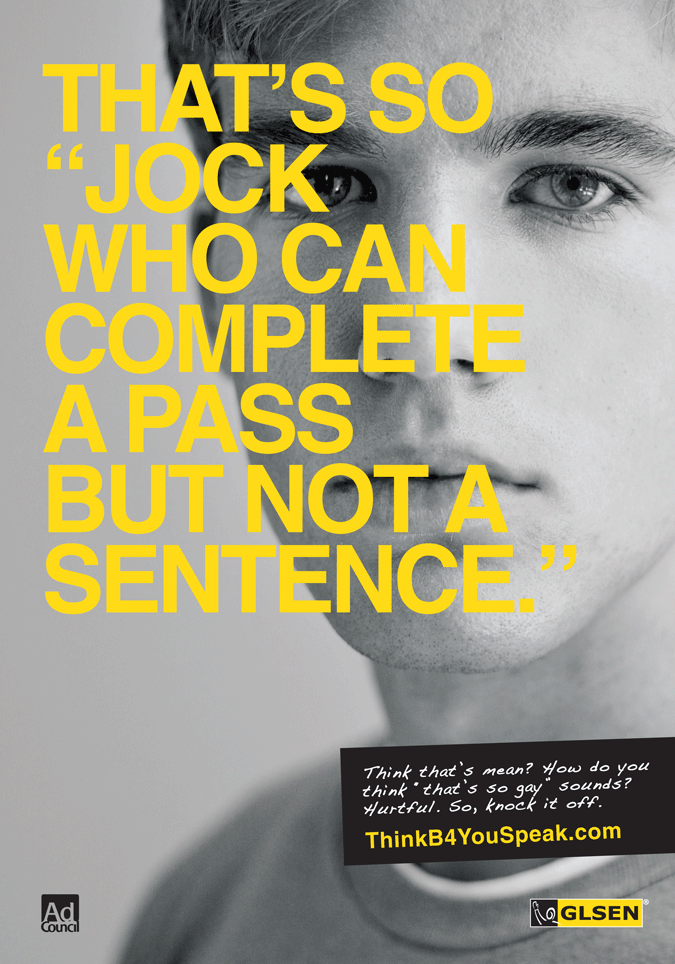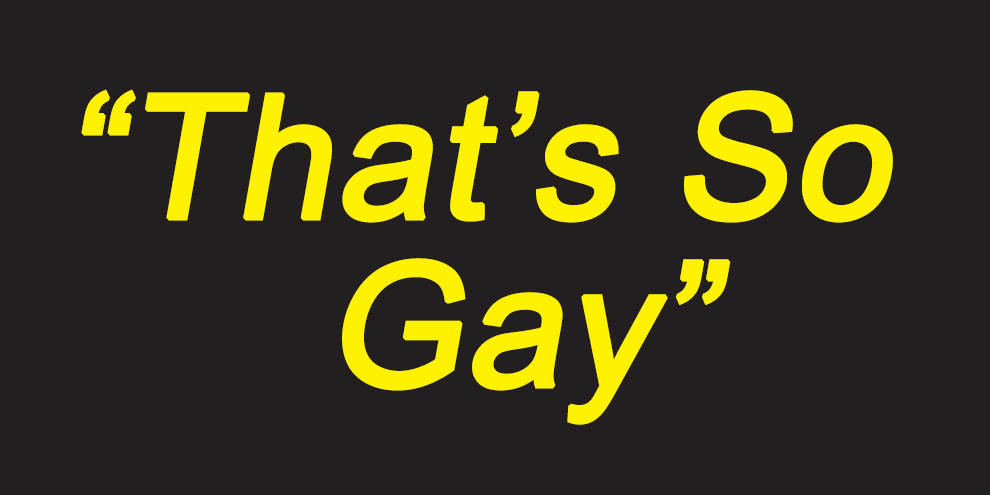Change your behavior
Editor’s note: Kristin Schwitzer is president of Beacon Research, Severna Park, Md. Dana Slaughter is head of Slaughter Branding, Dallas.
We can all remember what it was like to be a teenager. Each of us likely got more than enough advice and directions from parents, teachers and other role models about what to do and, sometimes more importantly, what not to do, as they tried to guide us on the path to being mature, thoughtful adults. Half the battle was just getting our attention; the other half was delivering the message in a way that got through to us.
So, imagine being given the challenge of persuading not just one teen but an entire generation of teenagers to stop being hurtful to others. This was the challenge presented last year to ad agency ArnoldNYC from The Ad Council and GLSEN (The Gay, Lesbian and Straight Education Network). Specifically, ArnoldNYC was tasked with raising awareness among straight U.S. teens around the hurtfulness to their gay, lesbian, bisexual or transgender (GLBT) counterparts of using slurs like “That’s so gay.”
As it turned out, step one was to grab teens’ attention. Step two was to get through to them on their terms.
Increasing frequency
Phrases and words like “That’s so gay,” “fag,” “faggot” and “dyke” are being used as insults with increasing frequency, creating an atmosphere, especially in schools, where GLBT teens feel disrespected, unwanted and unsafe.
In the spring of 2008, among the critical facts known about this situation were:
• 79 percent of high school students hear the words fag, faggot or dyke every day;
• 90 percent of GLBT teenage students are harassed and physically assaulted because of who they are or are perceived to be;
• GLBT students feel unsafe and are five times more likely to miss school, contributing to lower GPAs and college enrollment rates;
• every five hours, a gay teenager ends his or her own life; they are two to three times more likely than their straight counterparts to commit suicide.
While most teens don’t see themselves as bullies or bigots, they are rather apathetic about GLBT issues. For them, phrases like “That’s so gay” are part of their everyday vernacular and simply a habit.
To shift this mindset, the client team knew teens would not pay attention to another After School Special-type message that asked them to change their “ways,” so they aimed to find a compelling approach. “We wanted to be appealing but we didn’t want to be preachy,” says Joe Kosciw, research director at GLSEN. “If the advertising could help dial down the frequency of these behaviors, the school environment for GLBT kids should markedly improve.”
Open and thoughtful
GLSEN, ArnoldNYC and The Ad Council were looking for a quick way to test a wide array of potential creative with the teen target audience. Given that the ads were to be public-service announcements, the research budget was low and involved significant donations of professional time and services by various parties: ArnoldNYC, The Ad Council, Beacon Research, Slaughter Branding, 20/20 Research (recruiting) and Revelation Inc. (technology).
In addition, substantial money was saved by testing rough versions of the TV and radio ads, all created in-house by ArnoldNYC volunteers.
To be successful with the new campaign, the clients wanted a research solution that allowed teens to be honest, open and thoughtful about their reactions. They turned to online qualitative research, led by the authors.
The research objective was to get reactions from straight teens across the U.S. to a variety of potential ads so that the most relevant creative could be identified and strengthened prior to the October 2008 campaign launch. The study included exposing teens to: two TV ads; six print ads; one radio ad; two outdoor executions; one banner ad; six potential URLs; two Web site home pages; and 39 potential celebrity spokespersons.
Given the need to reach teens across America quickly on a rather sensitive topic, and to get their candid reactions (not those influenced by their peer group) to a lot of creative, the authors ruled out in-person focus groups and even online group methodologies. Instead, we chose a series of online one-on-ones using a research platform from Revelation. Both consultants had experience with this tool, and felt it could offer an efficient and effective way to conduct advertising research with teens.
The research design involved “talking” one-on-one with these teens across America for five consecutive days, right where they live - on the Internet. Each of the 50 respondents were required to log in to a secure research site for about 30 minutes per day. Moderating was conducted in an asynchronous format and participants were able to log in each day whenever it was convenient. The teens largely participated online right after school and then again late at night after dinner and once homework was done (sometimes they responded at midnight, surprisingly).
A total of 50 straight teens (ages 13 to 16) were recruited from across the U.S. using a hybrid online/phone approach. Cash honorariums were used, however the more-motivating incentive was a drawing for an iPod Touch among the 49 teens who finished all five days of the study. Respondents were self-described as neutral toward gays and lesbians. Half were in seventh or eighth grade and half in ninth or tenth grade; half were boys, half were girls. The participants were split into two groups (boys and girls), with each owned by one moderator.
Getting to know them
One of the keys used to get the teens to open up was to kick off the study by getting to know them first before jumping right into the advertising review. Day one was titled “All About Me” and used a photo-journal exercise to understand more about who they are as a person. In days two to four, reactions to the creative were gathered monadically, with stimuli rotated across interviews to prevent order bias.
A mid-study debriefing with the client team revealed the desire to modify the plan for the final day of data collection in order to explore some emerging themes in more detail. Thus, day five involved quickly gathering reactions to the 39 potential celebrity spokespeople, followed by an exploration of the overarching purpose of the campaign in more depth and an attempt to better understand how to take the message to the Internet and to teens in general. The study concluded by gathering feedback from the teens on what it was like to participate in this five-day online advertising research study.
Rich data resulted from the research, indicating that the campaign overall had succeeded in getting through to this cynical audience. The message had raised awareness of the issue (i.e., hurtfulness of GLBT slurs) without being seen as preachy. Teens “got it” and expressed a desire to change their behavior. Emily, a ninth-grader in Wisconsin, wrote, “I say [gay] and so do my friends. I never thought of it that way though and now I feel bad ... I still think they might say that because it’s habit right now. But they might not say it as much or would think before they said it.”
Teens shared that the use of humor and comedians in the TV ads definitely helped the message get through. One of the youngest participants, Emily, a seventh-grader in California, shared, “I really liked the TV commercials. I thought they would help the most. I think it would help some kids not to say [gay]. I think no matter what, they would start thinking it was wrong to say this.” Keana, a ninth-grader in Indiana, wrote, “[The Ellen DeGeneres TV ad] is easy to relate to, has some humor, and is effective because I thought about its message afterward. I think it would cause teens to think twice next time before they speak and realize what they say can affect the people around them.” And the ad’s direct, powerful call to action was said to be consistent with how teens speak and resonated very well. “[The ‘knock it off’ line] is good. It has that ‘cool teen vibe to it,’” said Genya, a tenth-grader in North Carolina.
Respondents helped strengthen the campaign’s ability to grab attention by suggesting stronger visuals and copy for the “That’s So” print ads, which played off the “That’s so gay” phrasing to drive home the point that seemingly offhand comments can be hurtful to others. Familiar stereotypes of a football player and a cheerleader (tested in outdoor ads) were seen as more attention-grabbing than the originally proposed “Quirky Girl” and “Hipster Guy” concepts for the print ads, therefore the football player and cheerleader became the key visuals for the print executions.
Some of the phrases used in the ads were seen as “not how teens talk,” so learning was obtained on what would be more relevant phrasing. In addition, participants shared that, while they liked the strong visual impact of these ads, they were too wordy and a bit difficult to read.
Making the message relevant to teens was also extremely important, and the research shed light on how to best accomplish this. Specifically, incorporating familiar teen situations in the TV ads (i.e., a group of teens at a pizza shop, two teen cashiers talking as they worked) and recognizable school frameworks (i.e., a dictionary-style print execution) engaged teens because the message was on their terms. Mack, a tenth-grader from New York, wrote, “[The dictionary print ad has] a learning tone. I think the ad just wants kids to understand how words can hurt and we need to understand the meaning of what’s being said out of our mouths.”
To make the campaign especially relevant to teens, the Web site was identified as a key area that needed improvement; teens suggested more interactive features and teen-appropriate messaging.
Finally, new channels of communication were identified as additional avenues to reach teens: in-school and movie theatres. Kevin, a ninth-grader in New Jersey, stated, “School is probably the best place to start because kids act different in school than they do at home. I hear a lot of kids cursing in school that would never curse in front of their parents.”
Research was completed in April 2008, and the campaign launched nationally in October 2008, including three TV spots, two print campaigns with three executions each, three radio spots, a campaign Web site (www.thinkb4youspeak.com) with viral videos and interactive content, and promotional materials for educators/schools and parents.
A multimedia strategy was used to ensure the campaign would break through to teens. Included in the campaign are humorous TV public-service announcements that star Hilary Duff and Wanda Sykes interrupting teenagers who use the phrase “That’s so gay.” Early reads on Web site traffic and visit duration have been strong, indicating that the online content is engaging teens. The campaign has received widespread media coverage, including CNN, The New York Times and TV shows The View, Entertainment Tonight, Good Morning America, The Today Show and The O’Reilly Factor.
In recognition of the campaign’s strategic and creative excellence, “Think B4 You Speak” received the Ad Council’s 2008 Golden Bell Award, beating out more than 50 Ad Council campaigns from the past year.
Open up and share
Overall, the online one-on-one research methodology allowed teens to open up and share their honest reactions in a safe environment where they were not being judged by their peers. They appreciated being probed about their responses and given the chance to explain themselves more fully. And, in the end, this resulted in better feedback and more data for the clients. “It was a very trustworthy source of learning that we keep going back to many months after completion,” says Jamie Tally, vice president, director business leadership, ArnoldNYC.
